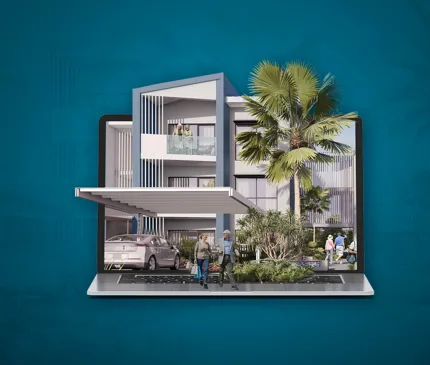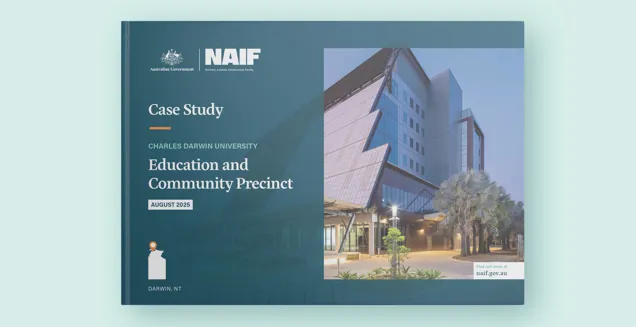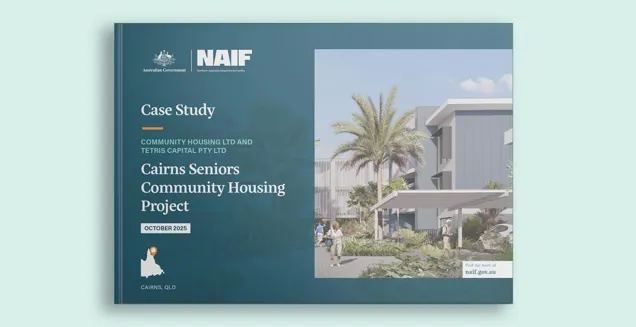NAIF Finance for Housing Infrastructure Webinar
If you missed the live session or want to revisit key insights, the recording for our Finance for Housing Infrastructure webinar is now available.

If you missed the live session or want to revisit key insights, the recording for our Finance for Housing Infrastructure webinar is now available.
Watch the full session featuring NAIF Chief Executive Officer, Craig Doyle, and Chief Investment Officer, Stephen Land, as they discuss key challenges and opportunities in the housing industry.
The webinar provides insights into the complex financial models needed to support housing development, a case study of our latest project in Cairns as well as answers to many questions that were raised by the audience.
Webinar Q&A
Accessing NAIF Finance
Given we are proponent led, who is eligible for NAIF finance and who is eligible for NT Infrastructure Loans?
We are sector-agnostic. Anyone can be eligible, provided they meet the investment criteria. Projects that can demonstrate the ability to repay or refinance a loan are eligible. There is no formal exclusion from eligibility.
Do builders/contractors require Federal Work Health & Safety (WHS) accreditation to undertake NAIF-funded projects, and does this vary based on project value?
Any project over $4 million requires Work Health and Safety (WHS) accreditation for the contractors. This ensures compliance with safety standards. Contractors need this accreditation either individually or through a lead contractor.
Can Aboriginal & Torres Strait Communities across the northern region access NAIF finance, considering capital housing project funding comes from the State and Federal Governments?
Yes, we can work alongside state or federal funding bodies to provide support to Indigenous businesses across northern Australia. There are no formal exclusions, and we aim to fill any gaps in financing.
Which geographic area does NAIF cover?
We can fund projects in parts of Queensland and Western Australia above the Tropic of Capricorn, as well as the whole of the Northern Territory. The area we cover has also been expanded to include the Australian Indian Ocean Territories of Christmas Island and Cocos (Keeling) Islands. It’s important to note that we are bound to this region by legislation, and we do not have quotas for specific areas. We assess each project on its merits, regardless of the location, as long as it is situated within our boundary. Take a look at our interactive map to see the exact border:
Will NAIF consider multiple infrastructure project proposals from the same proponent?
Yes, we will consider multiple proposals from the same proponent. Each project is assessed on its merits, regardless of the number of projects the proponent has.
Does NAIF have sustainability or climate adaptation requirements for projects in northern Australia?
Yes, we include sustainability and climate adaptation factors as part of our assessment process, considering environmental impact and renewable energy options.
Financing Options
Do you have any thoughts on financing for mixed-use developments, such as apartments with retail/commercial components?
Yes, we consider all types of projects, including mixed-use developments, on a case-by-case basis. We evaluate the revenue stream, including long-term leases, to assess the viability of the project.
How does NAIF assess public benefits into projects?
Public benefit is a key criterion in our decision-making process. Independent assessments are conducted to measure the benefits to northern Australia, and the Board reviews these before making investment decisions.
Do you have any advice on how organisations/projects can crowd-in private sector or equity investment?
We can help derisk projects, making them more attractive to private sector investors. We work with proponents to reduce risks and provide guidance on structuring the project for equity investment. To attract private sector or equity investment, organisations should highlight their project's commercial viability, risk management, and alignment with investor priorities like sustainability and long-term returns. Early engagement with investors, strategic finance structuring, and leveraging our concessional financing can help de-risk participation and unlock capital. Partnering with industry, government, and financial institutions further boosts confidence and investment potential.
What is the maximum loan term, and does refinancing reset the clock?
The maximum loan term is typically aligned with the project’s needs, with terms generally ranging from 10 to 20 years. We do not currently offer refinancing of our loans.
Can NAIF provide 100% project finance if required?
No, we cannot provide 100% financing for a project. We work within specific financial limits and help to derisk the project to make it more viable for the commercial market.
Will NAIF fund projects with residual property value exposure once the government subsidy ends?
Yes, we can consider funding projects with residual property value exposure, but each project is evaluated on a case-by-case basis depending on the location and nature of the project.
Can NAIF fund a staged infrastructure project that starts at $5 million and grows to $30 million?
Yes, we can consider funding projects in stages, though we typically prefer to fund larger projects upfront to reduce inefficiencies.
Can NAIF fund a small hotel expansion in Katherine?
Yes, we can assist with infrastructure projects like hotel expansions, subject to a minimum loan amount of $10 million. Projects above $4 million will need to meet workplace health and safety accreditation requirements.
Housing/Construction
Are there case studies or evidence on overcoming issues of government owned housing in regional areas distorting the market (i.e. incentives for government staff to buy versus rent GROH)?
We look at each project individually. While there may be challenges in some small communities, we work closely with the relevant governments to address any market distortions and ensure that the project remains viable.
What influence does NAIF have over the building process and local sourcing of materials?
We do not directly control the building process or material sourcing for funded projects. However, as part of our due diligence, we assess project plans, including commitments to local procurement and supply chains. Where possible, we encourage projects to maximise local economic benefits by engaging local contractors, suppliers, and Indigenous businesses. These commitments are often reflected in our funding agreements, ensuring projects contribute to regional development and job creation.
Has NAIF participated in any projects funded through the Housing Australia Future Fund facility?
Yes, the Cairns Seniors Community Housing Project was funded with a combination of NAIF funding and Housing Australia. We collaborate with Housing Australia on projects, particularly in the capital and operating stacks.
Would NAIF assist in setting up a modular factory in the NT?
Yes, we would support a modular factory if it meets all of our investment criteria, and we can collaborate with other agencies, like the National Reconstruction Fund, to provide equity and debt support.
Will NAIF consider projects with IBA (Indigenous Business Australia) for Indigenous housing or manufacturing?
Yes, we are supportive of the legislative changes allowing IBA to access funding for Indigenous projects, and we are open to partnerships with IBA for housing and business manufacturing projects.
Is there assistance for individual homeowners in urban consolidation projects in Alice Springs?
We do not provide funding for individual homes but may consider larger-scale housing projects across northern Australia.


